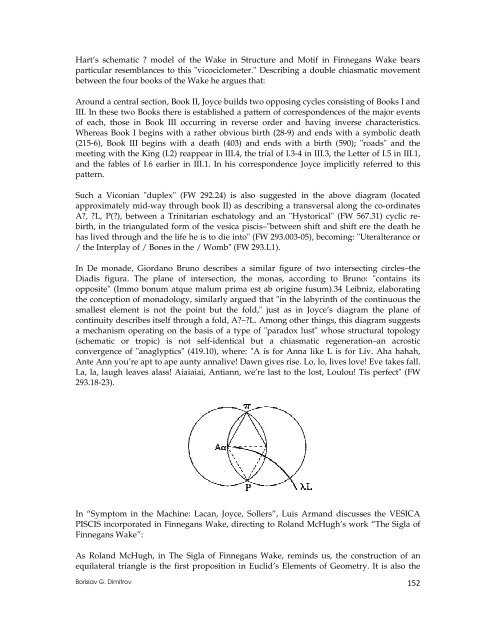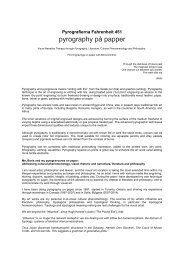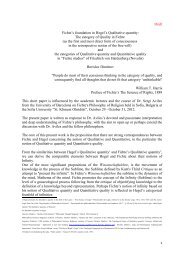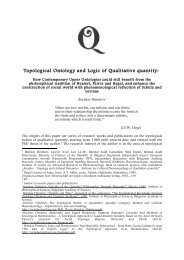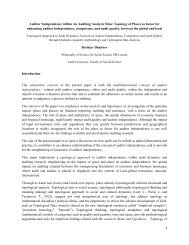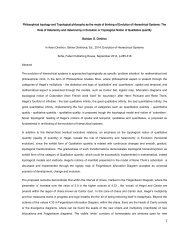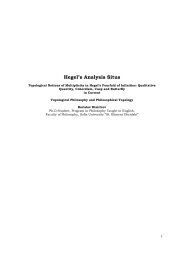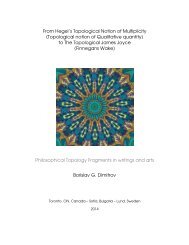o_194c354f0fne14b05mcimi6ppa.pdf
Create successful ePaper yourself
Turn your PDF publications into a flip-book with our unique Google optimized e-Paper software.
Hart’s schematic ? model of the Wake in Structure and Motif in Finnegans Wake bears<br />
particular resemblances to this "vicociclometer." Describing a double chiasmatic movement<br />
between the four books of the Wake he argues that:<br />
Around a central section, Book II, Joyce builds two opposing cycles consisting of Books I and<br />
III. In these two Books there is established a pattern of correspondences of the major events<br />
of each, those in Book III occurring in reverse order and having inverse characteristics.<br />
Whereas Book I begins with a rather obvious birth (28-9) and ends with a symbolic death<br />
(215-6), Book III begins with a death (403) and ends with a birth (590); "roads" and the<br />
meeting with the King (I.2) reappear in III.4, the trial of I.3-4 in III.3, the Letter of I.5 in III.1,<br />
and the fables of I.6 earlier in III.1. In his correspondence Joyce implicitly referred to this<br />
pattern.<br />
Such a Viconian "duplex" (FW 292.24) is also suggested in the above diagram (located<br />
approximately mid-way through book II) as describing a transversal along the co-ordinates<br />
A?, ?L, P(?), between a Trinitarian eschatology and an "Hystorical" (FW 567.31) cyclic rebirth,<br />
in the triangulated form of the vesica piscis–"between shift and shift ere the death he<br />
has lived through and the life he is to die into" (FW 293.003-05), becoming: "Uteralterance or<br />
/ the Interplay of / Bones in the / Womb" (FW 293.L1).<br />
In De monade, Giordano Bruno describes a similar figure of two intersecting circles–the<br />
Diadis figura. The plane of intersection, the monas, according to Bruno: "contains its<br />
opposite" (Immo bonum atque malum prima est ab origine fusum).34 Leibniz, elaborating<br />
the conception of monadology, similarly argued that "in the labyrinth of the continuous the<br />
smallest element is not the point but the fold," just as in Joyce’s diagram the plane of<br />
continuity describes itself through a fold, A?–?L. Among other things, this diagram suggests<br />
a mechanism operating on the basis of a type of "paradox lust" whose structural topology<br />
(schematic or tropic) is not self-identical but a chiasmatic regeneration–an acrostic<br />
convergence of "anaglyptics" (419.10), where: "A is for Anna like L is for Liv. Aha hahah,<br />
Ante Ann you’re apt to ape aunty annalive! Dawn gives rise. Lo, lo, lives love! Eve takes fall.<br />
La, la, laugh leaves alass! Aiaiaiai, Antiann, we’re last to the lost, Loulou! Tis perfect" (FW<br />
293.18-23).<br />
In “Symptom in the Machine: Lacan, Joyce, Sollers”, Luis Armand discusses the VESICA<br />
PISCIS incorporated in Finnegans Wake, directing to Roland McHugh’s work “The Sigla of<br />
Finnegans Wake”:<br />
As Roland McHugh, in The Sigla of Finnegans Wake, reminds us, the construction of an<br />
equilateral triangle is the first proposition in Euclid’s Elements of Geometry. It is also the<br />
Borislav G. Dimitrov 152


